Sown from Culture, Flourishing in Community
An Interview with Etienne Cakpo
BY EMMALY WIEDERHOLT
Etienne Cakpo is a dancer, choreographer, and musician originally from Benin, West Africa, as well as the director and lead choreographer of Gansango Music and Dance Company in Seattle, WA. He teaches and performs traditional African dance from Benin as well as contemporary African dance styles and has been building his dance repertoire for more than 30 years. He is currently on faculty at the University of Washington in Seattle where he teaches African dance technique. Here, Etienne reflects on how college dance programs are becoming more open to including Afro diasporic dance in their curriculums, but there is still not parity. He also shares how his classes have positively affected many of his students and how there is abundant cultural value in learning the dances of Africa.
This interview is part of Afro Diasporic Dance in College Settings, a series of interviews with dance professors who teach Afro diasporic dance forms in American college dance programs.
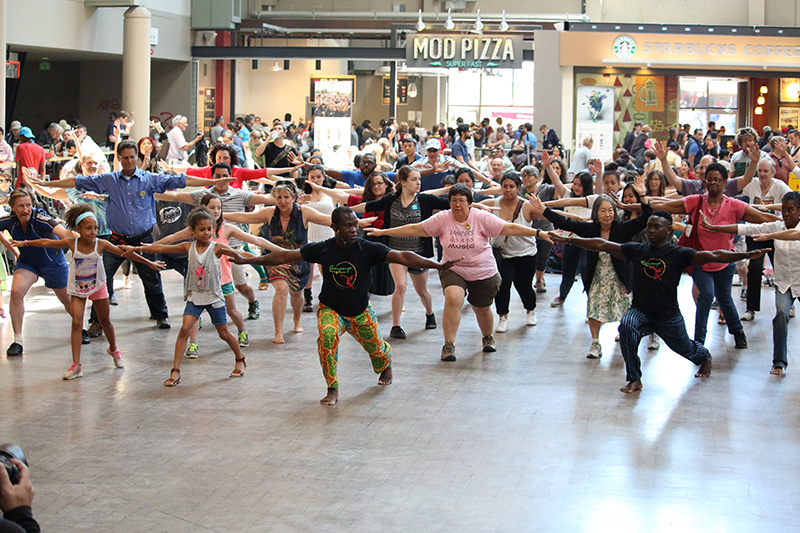
Photo by Siri Wood
~~
What was your introduction to dance and what have been some highlights or pivotal moments in your dance career?
I have been dancing since I was very young. Dance is an integral part of life in Africa. My family is animist; the dances they do are very spiritual. Going to the village with my mom and dad to be part of the ceremonies and feeling the connection between the drummers and dancers was so powerful. I was brought into it and wanted to learn. When I was seven years old, my friends and I created a group that performed around the neighborhood every December before Christmas for a holiday kind of like Halloween that we call Kaleta. We performed masked dances around the neighborhood to collect coins.
As I got older, people encouraged me by saying I was a good dancer, and I was drawn to it. I remember being mesmerized the first time I saw a video of Mikhail Baryshnikov dancing ballet. I got more serious about dance in my teen years, and when out of school I began performing for singers and performers who were well-known locally. I decided to pursue dance professionally when I was 20 years old and started teaching and collaborating with friends from Togo, Ghana, and Nigeria. Each person would present their style and we would teach together. We would teach three to four classes a week and I would also dance by myself every day. I eventually performed at the French Cultural Center in Cotonou and worked with visiting choreographers such as Kettly Noel from Haiti and Nicole Ponzo from France, so those were important points in my early career.
I began teaching at the University of Washington (UW) in 2017 and have continued since. I was invited several times before that to teach a one-off course before teaching regularly.
What is your current dance practice? How often do you teach, perform, and/or choreograph?
Over the past nearly two years during the COVID-19 pandemic, I’ve continued to teach public classes, but I shifted to online instruction for many months. Now there is more work back in the classroom, although some events and classes are still online. I teach public classes for all levels, and I teach in the UW’s Department of Dance program. I do a lot of residencies in elementary and middle schools as well. Performing with my company also gives me a lot of energy; we get small local arts grants to produce large public shows and we also present multicultural school assemblies and events at public libraries and community centers. I try to dance every day in any case!
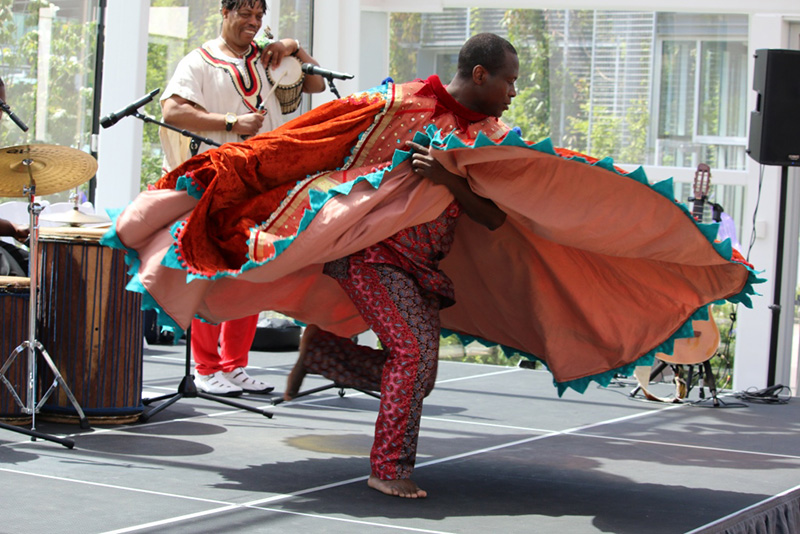
Photo by Siri Wood
Can you share more about Gansango Music and Dance Company? What kind of work does the company create?
My company Gansango Music and Dance was formed in 2001 after I arrived in Seattle. We have a core of around four to five artists from West Africa and the US who are master dancers and drummers, and we often expand the group to include additional artists depending on the type of event or client seeking our services. I create a lot of new contemporary choreography, some of which is purely modern, but much of which also draws from the vast repertoire of traditional rhythms and movements found across West African dance traditions, especially from my home country of Benin. We also present purely traditional dances from Benin and sometimes other countries. When we have resources to do so, we invite guest dancers from other countries to come and work with us, and that provides a lot of energy and inspiration when we can co-create in a multicultural group. Our work is diverse and wide-ranging, as can be gleaned from our more than 100 videos on YouTube found on the Gansango Dance channel.
Do you have an upcoming project or performance with Gansango you’d like to share more about?
Currently we don’t have large upcoming performance projects. The pandemic has forced us to focus more on basic teaching and smaller performance events. We certainly hope to identify grant funding to revive our Africa Remix performance series.
We produced the Africa Remix series in 2017 and 2019. We brought different groups of African dancers and performers together to share and co-create a multi-faceted show over a few weeks’ time. We organized a public dance workshop and then two nights of performances. We received a small grant from a local arts agency and collaborated with Langston, a nonprofit housed in Seattle’s Langston Hughes Performing Arts Institute. They contributed the theater space and helped with promotion. For the performance, our company invited Ida Faho, a guest artist from Burkina Faso. We also had local performers who were from Brazil, Togo, Ghana, Cote d’Ivoire, and Senegal. A lot of them are regular collaborators. Langston really liked it and so we produced Africa Remix 2 in 2019 and brought the same artist over from Burkina Faso. Our aspiration is to make it an annual tradition and perhaps turn it into a contemporary African dance festival at some point.
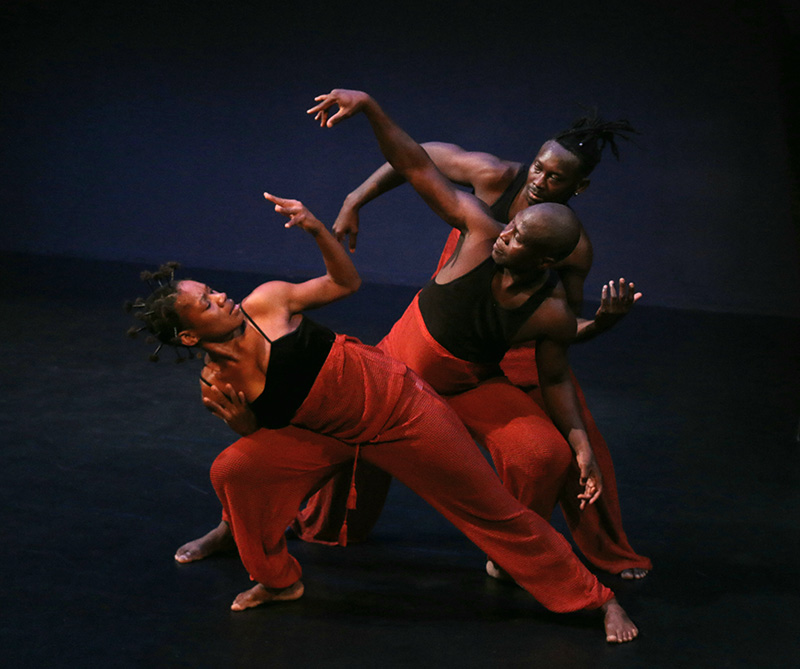
Photo by Siri Wood
Now I’d like to dive into your perspectives on academia. How long have you taught in academia? And what courses have you most often taught?
I have taught at the University of Washington since 2017, and I usually teach dance at the 200 or 300 level – beginning or intermediate African technique – a mixture of traditional and modern. I’ve taught two quarters that were classes in preparation for big performances, and those were really rewarding because the students worked hard at the choreographies, and they got to dance onstage in costumes for large audiences.
I primarily teach dances from Benin and dances from the West Africa region: Togo, Guinea, Ghana, Burkina Faso, Nigeria, and Senegal. And then I create my own technique by mixing a little bit of modern dance to make the movement a little easier for people here in the US. At UW, I teach a mixture of contemporary and traditional in the same class. I work with my students first on the rhythms and tempos and how to respond to the drum call. I teach them some basic traditional movements, but if I start teaching traditional dance without modifications, they get confused right away. Traditional Beninese dance is complex and polyrhythmic. You’ll see deeply bent knees, the ripple movement of the arms, the undulation of the back, opposing arm-leg movements, and close contact with the earth. If you try to teach that to a beginner, it’s too much at once. I take different aspects of the dance and teach them in isolation.
Since you started teaching in academia, have you seen more opportunities for students to study Afro diasporic dance forms?
Yes, especially over the past year or two with the increased emphasis on equity, diversity, and inclusion. UW has offered more classes taught by African instructors and focused on different styles from Africa and the diaspora. But it’s still not mainstream by any means.
Currently I am adjunct faculty. UW wants to hire someone fulltime, but they want someone with a masters or PhD in dance and with a background in African dance. The problem is you cannot go to school for two or four years and really know African dance. You find this with a lot of ethnic dance forms where the tradition has evolved from the culture, not from an academic standpoint. It can be analyzed from an academic standpoint, but it emerges from the tradition. In the US, a lot of African immigrants teach dance not from an academic perspective but from their traditional roots. That has a lot of value. But it doesn’t have as much credibility in the academic world; it’s like trying to fit a square pin in a round hole.
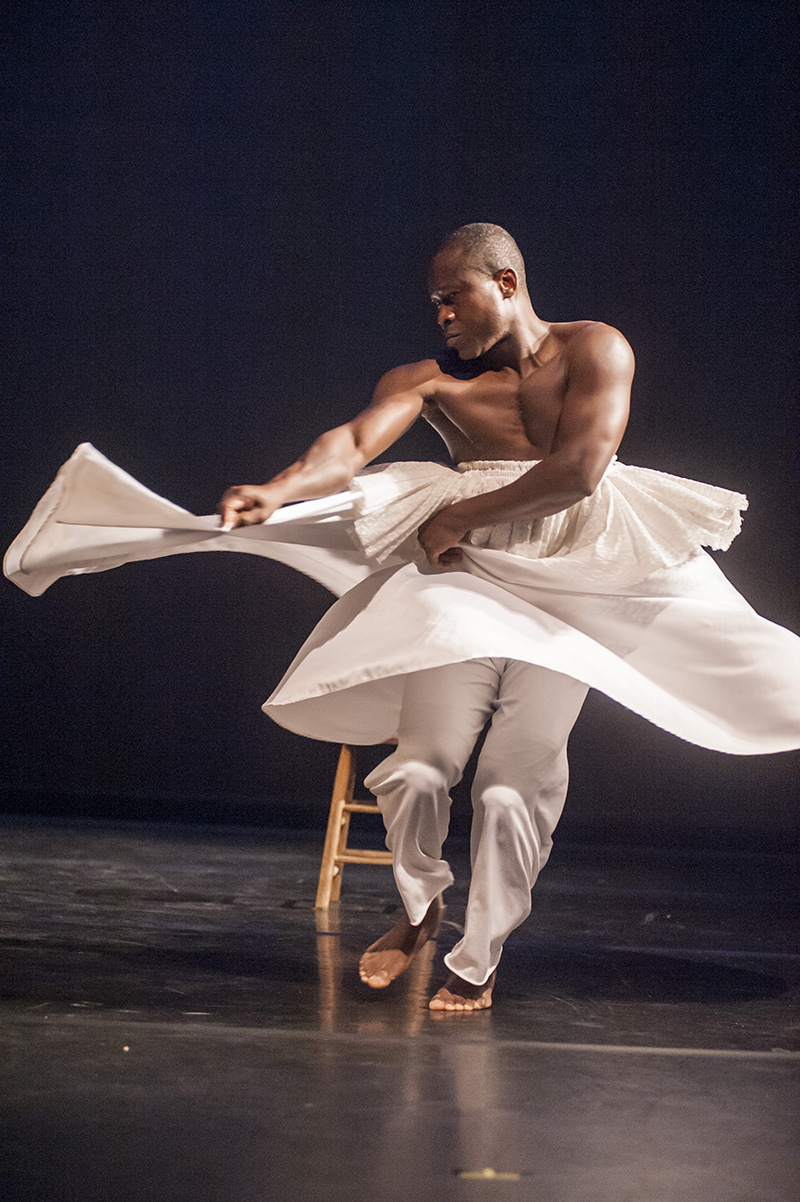
Photo by Erik Stuhaug
Where you’ve taught, are Afro diasporic dance forms treated as equally valuable as Western dance forms like ballet and modern? If not, what changes would you like to see in college dance curriculums?
No, I definitely feel that Afro-centric dance is not respected in the same way or on the same level as more classical Western styles. It’s less well-known and is viewed as not having as much philosophy, technique, or academic research behind it. For sure, Western forms such as ballet have vast literary and academic foundations underpinning them, and even forms such as tango or salsa are more well-known than dances from Africa and the African diaspora. But there is scholarship out there by African dance instructors, some of it limited to the French language. I do think African dance merits greater consideration and should be made more accessible for people to try. Many of my students at UW try my class as their first experience with African dance, and they are blown away – they love it and embrace it wholeheartedly!
The same is true of dance forms from Asia and Latin America for that matter; mainstream college curricula would benefit from offering more ethnic-based dance classes. And not just as a token offering, but with real consideration for what students are interested in, lack exposure to, or would find most enlightening. With 54 countries in Africa and more than 3,000 distinct ethnic groups speaking more than 2,000 languages across this vast continent, there is so much depth and breadth of culture to be explored through African dance!
While the culture-based dance traditions in Africa are strong and distinct, they are also evolving with younger generations. For example, you find very interesting forms such as Urban African/Afro/Afrobeat that are coming to the surface now and allowing for a lot of creativity and fusion of styles. A woman from Senegal/US is teaching Afro dance at UW this quarter. There are usually at least two Afrodiasporic dance classes offered each quarter – Capoeira, salsa, African technique, Afro, Tango, etc.
Why is it important for dance students to be educated in Afro diasporic forms? How does it create a better or more well-rounded dancer?
African dance has so much to teach us! There are dances that are ceremonial, social, religious, historical. Some tell stories, some teach us, some put us in closer contact with the elements of nature, many express joy through myriad movements. Most African dance is polyrhythmic and helps hone a dancer’s timing and tempo. Much of African and Afro-centric dance employs the ‘dooplé’ stance of bent knees and practices connection with the earth. This is immediately noticeable in traditional dance from Benin. This rooted stance contrasts starkly with the airiness and flight of ballet. And yet the jumps and leaps in African dance are remarkable because the movement springs up through the lower stance and can really articulate explosive joy. Dance from Guinea offers an excellent example of this.
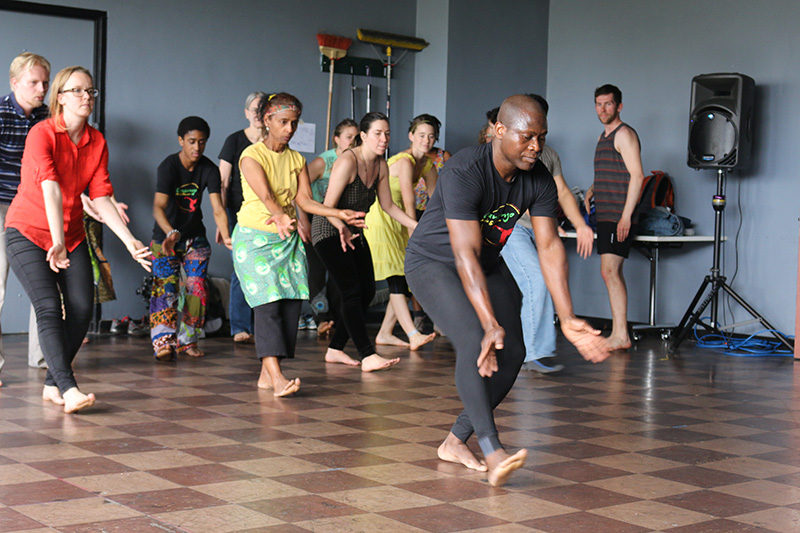
Photo by Siri Wood
During my classes, I build community. I encourage the students to not overthink and just feel their movements in relation to the live drumming. Many students experience a profound connection through this environment – the competitive edge of their Western dance classes falls to the wayside, and they let go of self-judgment and fear of moving “the wrong way,” and that’s a liberating experience. I know this because they share a lot of feedback with me, especially through journal/self-reflection writing assignments. Last quarter one student of mine from Japan submitted an essay that included this passage:
“When I was in elementary school, I took ballet classes, and when I was in junior-high and high school, I took jazz and hip-hop classes as well. I really enjoyed those classes, but nobody told me how dance is connected to mother nature. Nobody showed me what exactly dance is. They only told me techniques or rules. So, everything you told me in this class fascinates me and it feels like this is the first class that I felt I want to dance more and more from the very bottom of my heart… To tell the truth, I was about to shut down the eyes of my heart and stop dancing. [Through this course] I realized that my love and passion towards live performances has even gotten bigger and bigger!”
Many students, especially those from non-Western countries, also write about how the African dance classes help take them back to the joy they felt as a child dancing in their family circles or during their cultural festivals and rites. I love that African dance can put people in touch with that part of their identity, even when they are from North or South America, Asia, or other regions.
Any other thoughts?
I traveled to Colombia three years ago and went to a school to teach African dance. The way the Colombians picked up the dance was so natural. I only showed them the movement one time and they got it. A lot of them were Afro-Colombians. When African slaves were brought to Colombia, a lot of them ended up in the region called Chocó. When I heard the music they played, I thought I was in Benin. It’s the same with Brazil. Dancing, drumming, and singing are every day and everywhere. If we could have that here in the U.S., it would change people’s lives. At UW, I emphasize community building in my classes. I want the community to work together more and grow. The strength of dance in Africa is that it’s not done in isolation; it’s done in community.
~~
To learn more, visit gansango.com.
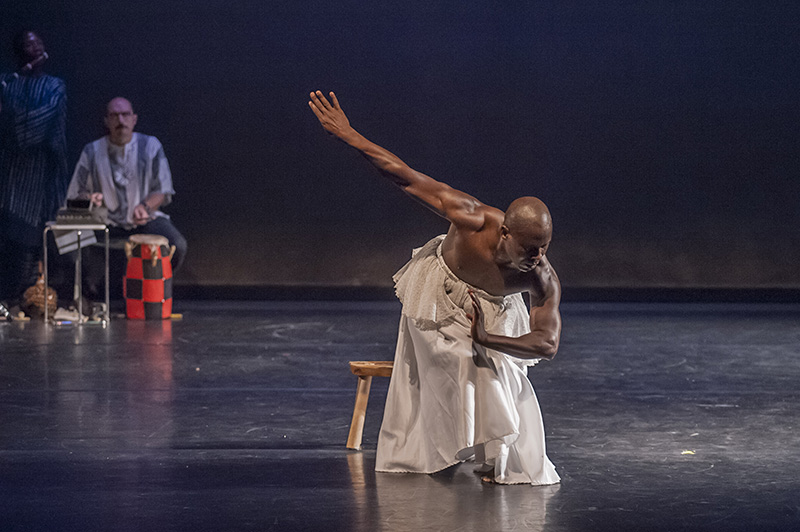
Photo by Erik Stuhaug

3 Responses to “Sown from Culture, Flourishing in Community”
Thanks Nikhita!
I loved this article. It really expresses the essence of African dance and it’s presence in the global world of dance.
this descriptive article is a splendid picture of Etienne’s passion..I am moved,indeed! Thank you,Eti,for the experience.love,Martha
Comments are closed.